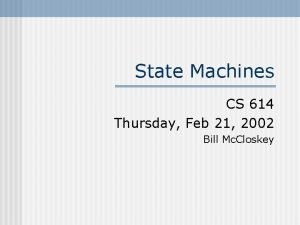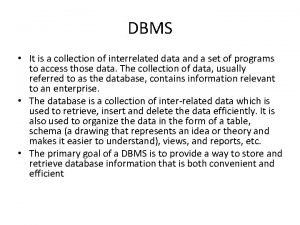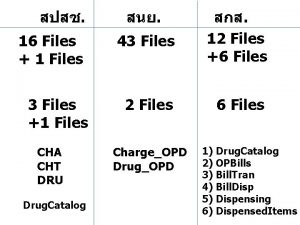Journalism 614 Relationship testing Reading data files Survey

















- Slides: 17

Journalism 614: Relationship testing

Reading data files ¨ Survey questionnaire (word): ¨ Survey data (excel): – Each row: a respondent – Each column: a variable (question/condition) ¨ For easy data management, copy your columns and the demographic variable columns and paste a clean excel file ¨ Keep an eye out on the correspondence between response categories and coded values

Experimental design Condition 1 Condition 2 Response

How to test the effects? ¨ Condition 1: The majority of public university funding is tax revenue from U. S. citizens. The U. S. government shouldn’t allow undocumented immigrants to access public education. ¨ Condition 2: The majority of public university funding is tax revenue from U. S. citizens. The U. S. government shouldn’t allow illegal immigrants to access public education. ¨ Response categories: – – – Strongly disagree (1) Somewhat disagree (2) Neither disagree nor agree (3) Somewhat agree (4) Strongly agree (5)

Step 1: Compare means ¨ Mean(undocumented immigrants): 3. 23 ¨ Mean(illegal immigrants): 3. 54 ¨ Statistical test: ONE-WAY ANOVA

Step 2: Compare distribution of responses strongly disagree undocumented immigrants illegal immigrants somewhat strongly disagree neither agree total 20 6 18 11 27 82 7 10 19 18 24 78 Figure 1:

Step 2: Compare distribution of responses strongly somewhat strongly disagree neither agree undocumented immigrants illegal immigrants total 24% 7% 22% 13% 33% 100% 9% 13% 24% 23% 31% 100% Figure 2:

Step 3: Compare responses within a question strongly somewhat strongly disagree neither agree undocumented immigrants illegal immigrants total 24% 7% 22% 13% 33% 100% 9% 13% 24% 23% 31% 100%

Step 3: Compare responses within a question strongly somewhat strongly disagree neither agree undocumented immigrants illegal immigrants total 24% 7% 22% 13% 33% 100% 9% 13% 24% 23% 31% 100% ¨ Undocumented immigrants condition: ¨ Strongly disagree (24%) vs Strongly agree (33%) ¨ Disagree (31%) vs Agree (46%)

Step 3: Compare responses within a question strongly somewhat strongly disagree neither agree undocumented immigrants illegal immigrants total 24% 7% 22% 13% 33% 100% 9% 13% 24% 23% 31% 100% ¨ Illegal immigrants condition: ¨ Strongly disagree (9%) vs Strongly agree (31%) ¨ Disagree (22%) vs Agree (54%)

Step 4: Compare the same response category of two conditions strongly somewhat strongly disagree neither agree undocumented immigrants illegal immigrants total 24% 7% 22% 13% 33% 100% 9% 13% 24% 23% 31% 100%

Step 4: Compare the same response category oftwo conditions strongly somewhat strongly disagree neither agree undocumented immigrants illegal immigrants total 24% 7% 22% 13% 33% 100% 9% 13% 24% 23% 31% 100% ¨ Do we have statistical significance in the difference of the percentages of respondents who strongly disagreed?

Step 4: Compare the same response category of two conditions strongly somewhat strongly disagree neither agree undocumented immigrants illegal immigrants total 24% 7% 22% 13% 33% 100% 9% 13% 24% 23% 31% 100% ¨ Do we have statistical significance in the difference of the percentages of respondents who strongly agreed?

Step 5: Demographics ¨ How do demographic characteristics affect responses? ¨ Party ID, news consumption, education, gender, age, race, etc. ¨ Statistical test: Multivariate Regression

Step 5: Demographics ¨ Party ID Figure 3:

Step 5: Demographics ¨ New consumption Figure 4:

Step 6: Interpret and draw conclusions ¨ Summarize the responses in two conditions (mean, within, between, relevant demographic variables) ¨ Highlight the differences in response that are statistically significant ¨ Draw conclusion: is your media effect hypothesis confirmed or disconfirmed? ¨ Any methodological notes about your data?
 File mode python
File mode python Cjis security policy
Cjis security policy Cjis meaning
Cjis meaning Cs 614
Cs 614 914-614-3221
914-614-3221 Literary journalism vs traditional journalism
Literary journalism vs traditional journalism Literary journalism vs traditional journalism
Literary journalism vs traditional journalism Pre reading while reading and post reading activities
Pre reading while reading and post reading activities Data flow testing strategies in software testing
Data flow testing strategies in software testing Acls abcde
Acls abcde Data files in c
Data files in c Inter related data
Inter related data A survey of the history of intelligence testing reinforces
A survey of the history of intelligence testing reinforces Software testing survey questions
Software testing survey questions What is domain
What is domain Motivational overview of logic based testing
Motivational overview of logic based testing Positive testing vs negative testing
Positive testing vs negative testing Cs3250
Cs3250
































